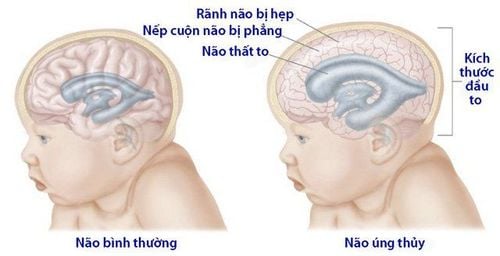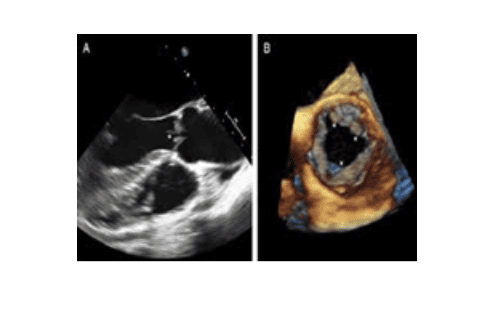This is an automatically translated article.
The article is expertly consulted by Master, Doctor Nguyen Minh Tuan - Pediatrician - Pediatrics - Neonatology - Vinmec Danang International General Hospital.When the ultrasound results show that the fetus has 10mm or more dilated ventricles, many women begin to worry about whether the dilated ventricles are dangerous, what should the fetus with dilated ventricles eat to return the baby's condition? normal. The following article will answer questions around the severity of this disease.
1. General information about ventricular dilatation
1.1. Ventricular dilation at the end of pregnancy In the ventricles of the fetus and adult there is always a certain amount of cerebrospinal fluid, with the function of protecting the brain and spinal cord. The average fetal ventricular fluid was measured <10mm. But when children encounter disorders in the process of production, circulation and absorption of cerebrospinal fluid, it will lead to dilation of the ventricles. If the amount of fluid is obstructed or stagnant, it will cause increased intracranial pressure. Specifically:Ventricular fluid > 10mm: Mild ventricular dilatation; Ventricular fluid > 20mm: Severe ventricular dilatation; Compression or destruction of brain parenchyma: Hydrocephalus. Through ultrasound, the doctor can know the dilation of the fetal ventricles. Around the 22nd week, 10mm ventricular dilatation on the left border is not a concern because usually after 32 weeks, the ventricular dilatation at the end of pregnancy will return to normal. But if antenatal ultrasonography shows a ventricular diameter of 18-19mm, the risk of developing true ventricular dilatation is up to 80%. However, continuing to monitor the pregnancy, the ventricles tend to be smaller, fluctuating to about 13-14mm when ultrasound right before birth is considered a good sign. Your baby is more likely to have ventriculomegaly and will settle down on their own over time.
Currently, there is no antenatal intervention for the fetus with dilated ventricles. Therefore, experts do not have any advice for pregnant women with a fetus with dilated ventricles what to eat.
1.2. Ventricular dilatation in neonates In the case of ultrasound showing severe ventricular dilatation at the end of pregnancy, postpartum follow-up is required for a long time, about 12-24 months. If the baby is 1 week old and the head circumference is 32cm, it is normal. On the contrary, when the doctor assesses the serious progress of the disease through the follow-up visits, the baby can be surgically drained of the cerebrospinal fluid to avoid compression of the brain parenchyma, to prevent increased intracranial pressure.
In newborns, is ventricular dilatation dangerous? In most cases, cerebrospinal fluid pressure will increase, causing a range of rather dangerous symptoms. In which, the most prominent is the increasing size of the skull, manifested by widening of the anterior fontanelle and joints, and at the same time the veins in the forehead are also dilated, making the baby's head look like many blue veins. The intelligence of children with brain-related diseases is often severely affected.

2. Causes of ventricular dilatation
Fetal and newborn babies can have dilated ventricles of 10mm or more due to some of the following congenital causes:Obstruction of cerebral aqueduct or superior vena cava; Dandy - Walker or Chiari deformities; Abnormal veins of Galen; Intraventricular hemorrhage; Infection in the mother's uterus (TORCH). In addition, a number of other acquired conditions can also lead to ventricular dilatation in children, including:
Infections: Purulent meningitis, tuberculosis or parasitic cysts; Hemorrhage: Hemorrhage of the ventricles and subarachnoid area; Brain tumors ; Venous malformation of Galen (rare disease); Head trauma; Effects of neurosurgery, causing bleeding into the ventricular system.
3. Dangerous symptoms of ventricular dilatation
3.1. In premature infants and young children For preterm infants, the risk of ventricular dilatation can be detected by measuring head circumference to assess for abnormalities. In case of increased intracranial pressure will be accompanied by some signs such as:fontanelle bulge; Varicose veins of the scalp and skull joints; Sometimes the heart beats slowly, there is a pause in breathing; Paralysis of the oculomotor nerve, always looking down (rare). In the case of small children with fontanelles, in addition to the symptoms of scalp veins, heart and vision similar to those above, some of the following symptoms may appear:
Big head, growing faster than the whole body. face; The fontanel is swollen, widening the lines of the skull joints; Baby is fussy, easily irritated and vomiting; Difficulty holding or turning the head. 3.2. In older children In older children, if they fall into an acute state of hydrocephalus, there will be some of the following symptoms:
Dull headache, increasing gradually after waking up and decreasing after vomiting; Vomiting protruding into the faucet; Changing perception; Double vision (1-2 vision), blurred vision or papilledema due to paralysis of the VI oculomotor nerve. Meanwhile, signs of chronic hydrocephalus include:
Big head, head circumference > 90th percentile; Ataxia, loss of control of voluntary muscles; Mental development disorder.

4. Complications of ventricular dilatation surgery
Currently, ventricular dilatation in children has appropriate treatment measures, even if the disease is mild (ventricular dilatation 10mm or less) sometimes only need to be monitored and self-healing after a while. Although surgical treatment, including placement of a CSF shunt and endoscopic third ventricle floor catheterization, is curative for the child, there are some potential risks.For shunt systems, possible risks include:
Drainage valve cord is mechanically obstructed, broken or the shunt tip is out of place, the patient is allergic to the material of the shunt; Excessive drainage or CSF leak; Subdural hematoma; Slit ventricular syndrome; Pseudocyst at the tip of the intraperitoneal shunt; Epileptic; Metastasis of cancer cells caused by brain tumors draining to other parts of the body. For laparoscopic surgery risks may include:
Infection of the incision; Meningitis; Transient memory loss; Trauma to the hypothalamus; Ocular nerve paralysis; Cerebral vascular damage. In summary, ventricular dilatation is a rather dangerous condition that can happen to fetuses and young children. Currently, there is no intervention for babies in the womb. Therefore, pregnant women need to follow regular pregnancy ultrasound to detect fetal abnormalities early. In particular, the 12th week ultrasound plays an extremely important role to help give the most accurate diagnosis results. From 12 weeks old, the baby has developed relatively fully in terms of morphology and has reflexes such as flexing and stretching the body, stretching the limbs... This is also one of the 03 important ultrasound landmarks of malformations recognized by experts. recommendations should be made. During this ultrasound, doctors will especially check and screen for early abnormalities of the brain, face, heart, digestive, urinary, extremities and the whole body. Because the baby is still quite small, a high-end 4D ultrasound system like the GE Voluson E10 will play a very important role in helping doctors at Vinmec detect more than 95% of abnormalities during this period. Packed with the latest technologies, the GE Voluson E10 enables enhanced image quality and penetration for outstanding high-resolution images and easy operation.
If it is determined that the ventricles are dilated at the end of pregnancy, after the baby is born, it must be taken for an MRI or brain computed tomography scan according to the schedule specified by the doctor. This will support well in the process of diagnosing the cause and investigating the accompanying malformations, as well as deciding on the correct and timely treatment direction.
Pediatrics department at Vinmec International General Hospital is the leading prestigious address, receiving and examining diseases of infants as well as children. With modern equipment, sterile space, minimizing the impact as well as the risk of disease spread. Along with that is the dedication from the doctors with professional experience with pediatric patients, making the examination no longer a concern of the parents.
Master. Doctor. Nguyen Minh Tuan has over 27 years of experience in the field of Pediatrics. Doctor was former Deputy Department of Pediatrics - Da Nang Obstetrics and Gynecology Hospital before working as a Pediatrician at the Department of Pediatrics - Neonatology - Vinmec Danang International General Hospital as it is today.
Please dial HOTLINE for more information or register for an appointment HERE. Download MyVinmec app to make appointments faster and to manage your bookings easily.














